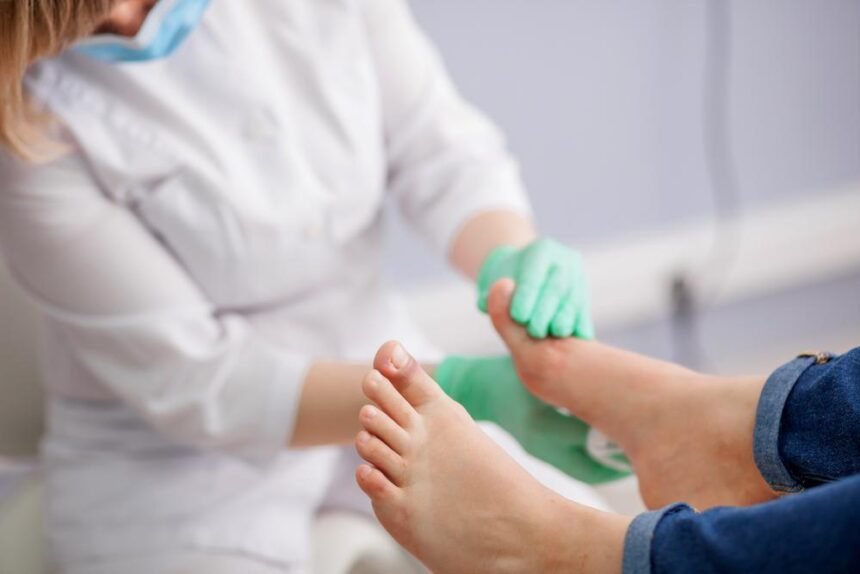Diabetes can affect many aspects of your health, and one surprising indicator may be right at your fingertips—literally. If you’ve noticed yellowing fingernails, it could be more than just a cosmetic concern. For those managing diabetes, this discoloration might signal underlying issues that need attention. Understanding the connection between diabetes and yellow fingernails is crucial for maintaining both nail health and overall well-being. In this guide, we’ll explore the reasons behind this condition, how to care for your nails effectively, and natural remedies to help you regain their former glory. Let’s dive into the world of diabetes yellow fingernails and empower ourselves with knowledge!
A Comprehensive Guide to Treating diabetes yellow fingernails
Treating diabetes yellow fingernails starts with understanding the root cause. Regular monitoring of blood sugar levels is essential for overall health, including nail appearance.
Proper hygiene plays a vital role in treatment. Keep your nails clean and dry to prevent any infections that may worsen discoloration. Gently trim and file them regularly, avoiding harsh chemicals or excessive filing that can damage the nail bed.
Hydration is another key factor. Drinking plenty of water helps maintain moisture levels in your body, promoting healthier nails. Consider using moisturizing creams specifically designed for hands and nails as well.
Incorporating nutrient-rich foods into your diet can also aid recovery. Foods high in vitamins A, C, D, and E support nail strength and growth while combating discoloration effects.
Consulting a healthcare professional about suitable treatments or medications tailored to managing diabetes may provide additional benefits for maintaining healthy fingernails.
Why Do diabetes yellow fingernails Occur?
Diabetes yellow fingernails can be a subtle indicator of an underlying problem. When blood sugar levels are not well controlled, it affects circulation and the body’s ability to heal. This compromised health manifests in various ways, including nail discoloration.
High glucose levels lead to dehydration. As nails lose moisture, they become brittle and may develop a yellow tint. Fungal infections also thrive in individuals with diabetes due to weakened immune systems, further contributing to this issue.
Moreover, certain medications used for diabetes management may alter nail appearance as a side effect. Nutritional deficiencies related to diabetes can play a role too; insufficient vitamins such as biotin or zinc often result in unhealthy nails.
These factors create a perfect storm that results in yellowing nails among those living with diabetes. It’s vital to pay attention when you notice changes—your body could be signaling something more significant at play.
10 Tips for Caring for diabetes yellow fingernails
Taking care of diabetes yellow fingernails requires a gentle touch and consistent effort. Start by keeping your nails clean. Regular washing with mild soap helps prevent infections.
Moisturizing is essential too. Use a rich hand cream or lotion to keep your nails and cuticles hydrated. This can prevent further discoloration and damage.
Trim your nails regularly but avoid cutting them too short. Keeping them at a manageable length reduces the risk of breakage, which can lead to complications.
Consider wearing gloves while doing chores, especially those involving chemicals or prolonged water exposure. Protecting your hands minimizes stress on your nails.
Maintain a balanced diet rich in vitamins and minerals that support nail health—biotin, zinc, and omega-3 fatty acids are key players here. Small changes can make a big difference over time.
What Causes diabetes yellow fingernails?
Diabetes yellow fingernails can be alarming and are often linked to several underlying issues. One primary cause is poor circulation, which affects blood flow and nutrient delivery to the nails. This deficiency can lead to discoloration.
Another factor is high blood sugar levels. Elevated glucose not only impacts overall health but also the condition of your nails, leading to a yellowish hue over time.
Fungal infections present another concern for diabetics. Weakened immune systems make it easier for these infections to take hold, causing changes in nail color and texture.
Additionally, some medications prescribed for diabetes may have side effects that manifest as yellowing nails. Always discuss any noticeable changes with your healthcare provider.
Inadequate hygiene practices combined with diabetes management challenges may exacerbate nail issues, contributing further to this unwanted appearance.
10 Natural Remedies for diabetes yellow fingernails
Natural remedies can provide relief and improve the appearance of diabetes yellow fingernails. Here are ten options to consider.
Coconut oil is a powerhouse for nail health. Its antifungal properties help fight infections while keeping nails moisturized.
Lemon juice acts as a natural bleaching agent. Apply it directly to your nails, allowing its acidic nature to lighten discoloration effectively.
Tea tree oil offers antibacterial benefits that can combat fungal growth. Dilute it with a carrier oil and massage onto affected areas regularly.
Apple cider vinegar is another great option. Soaking your nails in this solution may restore their brightness over time.
Garlic possesses anti-inflammatory qualities that promote healing. Rub fresh garlic on the nails or include it in your diet for added benefits.
Baking soda works wonders too, acting as an exfoliant to remove dead skin cells from around the nail bed.
Aloe vera gel hydrates and soothes damaged nails, fostering better overall health when applied consistently.
Adding more vitamin E-rich foods like almonds into your diet can enhance nail strength and appearance significantly.
Hydration plays a key role; drink plenty of water to keep both skin and nails nourished from within.
Incorporating biotin supplements may support stronger, healthier nail growth over time.
How Can diabetes yellow fingernails Be Prevented?
Maintaining proper hygiene is crucial for preventing diabetes yellow fingernails. Clean your nails regularly to remove dirt and bacteria that can contribute to discoloration.
Keep your fingernails trimmed short. This reduces the risk of injury, which can lead to infections and further complications associated with diabetes.
Stay hydrated by drinking plenty of water throughout the day. Hydration helps maintain healthy skin and nails, reducing the chances of yellowing.
Monitor your blood sugar levels diligently. Consistent management keeps diabetes-related symptoms in check, including nail discoloration.
Incorporate a balanced diet rich in vitamins and minerals. Nutrients like biotin, zinc, and vitamin E support overall nail health and resilience against changes caused by diabetes.
Avoid harsh chemicals found in some nail products that may worsen discoloration or weaken the nails over time. Opt for gentle formulas instead.
Conclusion
Diabetes yellow fingernails can be an alarming sign of underlying health issues. Understanding the causes and taking proactive measures is essential for managing this condition effectively. By incorporating proper nail care, exploring natural remedies, and maintaining overall health through lifestyle changes, you can protect yourself from potential complications associated with diabetes yellow fingernails.
Regular check-ups with your healthcare provider will help monitor any changes in your nails and general well-being. Staying informed about your diabetes management plays a crucial role in minimizing risks. Prioritize self-care routines that promote healthy nails while being mindful of how they reflect broader health concerns.
Taking action now not only improves the appearance of your nails but also contributes to better overall health outcomes. Remember, knowledge empowers you to make informed choices for a healthier future.




